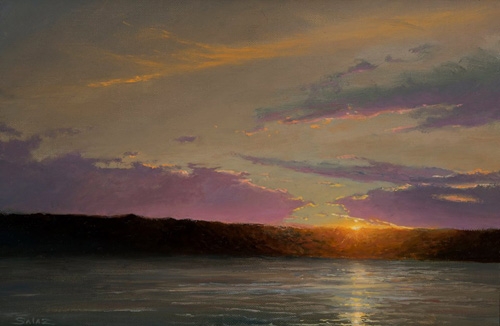
We’ve all watched sunsets. The colors change dramatically every few seconds. New York painter Kenneth Salaz seems to catch the height of those fleeting colors in his Hudson Valley sunsets. How does he do it?
Salaz reveals that the biggest “trick” for painting sunsets is to spend a lot of time looking at sunsets, and a lot of time painting them. “You have to study the sunsets without painting them, then paint them starting 30 minutes ahead,” says the artist. “Start with the value in the sky that you know is going to be there. Then when the light is right, put the chroma in. A friend of mine said, ‘You are painting a moving bullet!'”

Step 1. Salaz begins with a dry toned canvas with a neutral color that tends toward blue.

Step 2. In the first 10 to 15 minutes of the painting session, the artist focuses on the overall value scheme. While the sky dries, he brushes in an atmospheric landscape in the middle ground.

Over the next 30 minutes, Salaz adds the various layers of clouds, and sketches in the water.
Salaz continues, “In one stretch, I painted three sunsets a day for two weeks. I was accustomed to where it was going to go in terms of value and color. I premixed all the colors on the palette, including strings moving from pink to purple.”
They aren’t simple artist studies; Salaz paints on linen, and he sells these little 6″-x-9″ jewels. A few get snapped up by collectors immediately.

For the following 10 minutes, the artist begins painting details, starting near the sun. He specifies the cloud bank details, and begins adding details to the water.

In the final 10 or 15 minutes of the painting session, Salaz focuses on color. “I can concentrate on the color since the values are all in correct hierarchy,” he says. “I finish with the atmospheric effect of the water and trees.”

The completed painting: “Sunset Over Palisades,” by Kenneth Salaz, 2014, oil
Salaz has some technical methods to aid in his sunset paintings. He utilizes a mixture of turpentine and stand oil to help the paint application dry fast enough to create layers. He paints on a canvas toned a neutral gray leaning toward blue. He saves color for last. “For the first 10 or 15 minutes, I focus on the overall value scheme, and only secondarily, color,” says the artist. “Value is the most important element. While the sky dries, I set up the atmospheric landscape in the middle ground. Next I add the different layers of clouds and sketch in the water, then I begin details near the sun, specify the cloud bank, and begin painting water details. In the final 10 or 15 minutes I focus on the color. I finish with the atmospheric effect of the water and the trees.”
Salaz lived in New York City for years, but he recently moved up the Hudson River to the Westchester County area specifically to paint Hudson River Valley scenes like these. His focus is paying colorful dividends.




